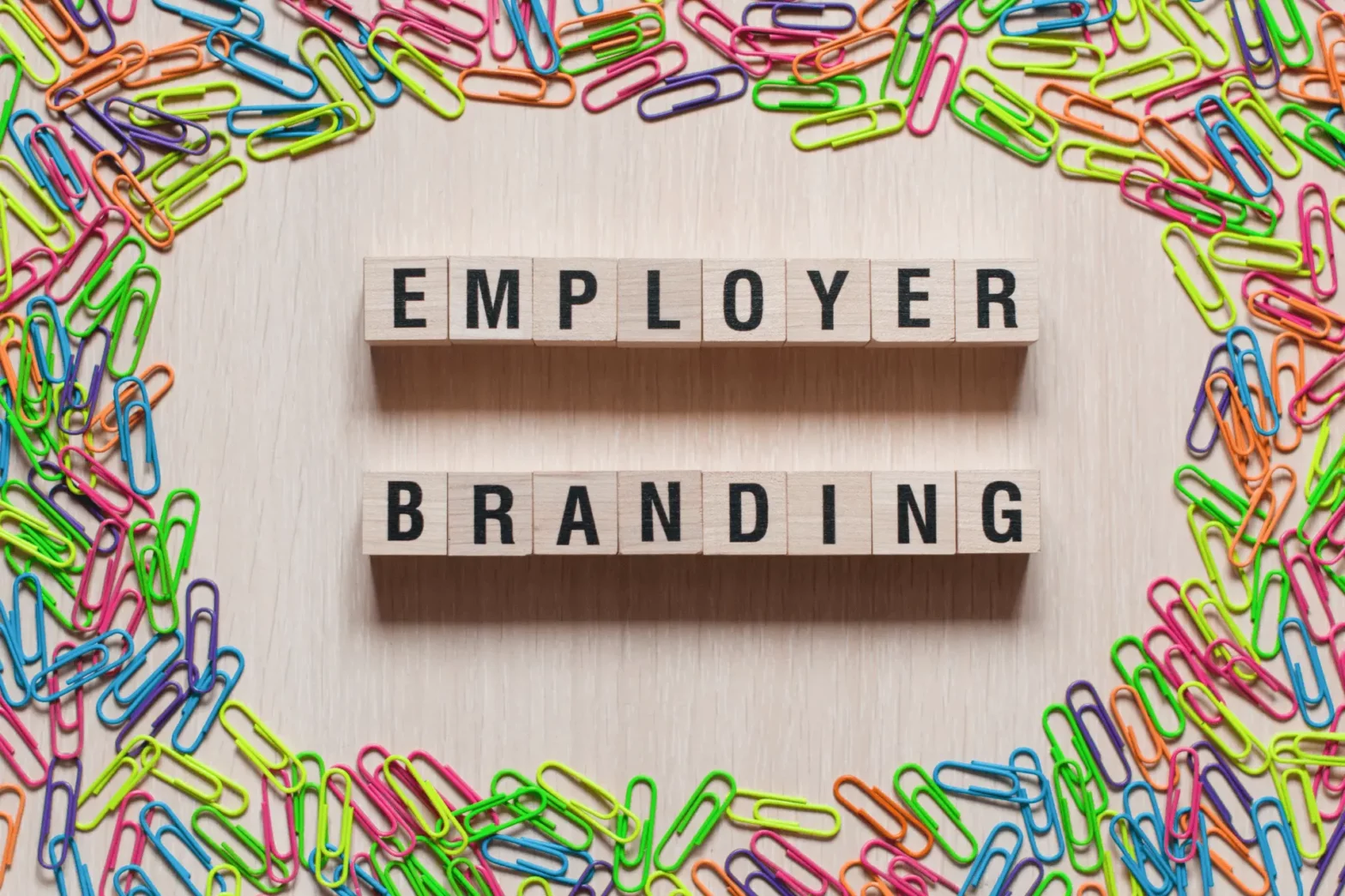
How to Improve Employer Branding with Storytelling
Telling stories about your culture, milestones, and team achievements makes your brand more memorable, relatable, and attractive to top talent. These stories tie into your company’s reputation and shape how both existing employees and potential hires perceive your workplace.
Facts and ideas stick better when paired with a story. Employer branding works the same way. Successful tuition assistance stories, for example, resonate more with job seekers than “great company culture” promises
Stories help people connect with your company on a deeper level. They showcase your company as more than just a place to work. Ultimately, they help you stand out in a sea of high-paying jobs by highlighting the meaning, connection, and shared purpose within your team.
In this article, we’ll show you exactly how to improve employer branding through storytelling. Learn strategies, examples, and practical tips to help attract top talent, strengthen your reputation, and inspire loyalty.
| How to Improve Employer Branding with Storytelling |
What Is Employer Branding?
Employer branding refers to the set of strategies a company uses to shape and promote its reputation as a workplace. It’s an important aspect many job seekers consider when applying for roles, helping them build a positive impression on your company. A strong employer branding helps you attract and retain top marketing talent, build trust with employees, and position your company as a “Great Place to Work.”
Many organizations equate employer branding with a set of perks or policies, but it runs much deeper. Aside from the obvious elements like compensation and benefits, it also covers:
- Workplace culture
- Hiring process
- Employee experience
- Career growth & development
- Internal & external communications
- Leadership/management
- Employee advocacy
- Community & social impact
Fun fact: Around 83% of employees research a company’s reputation (through reviews and ratings) before applying. Creating a compelling employer brand helps you ensure that the right people find you instead of you constantly searching for them.
Why Is Employer Branding Important?
Employer branding directly affects your ability to attract, hire, and keep the right people. A positive employer brand signals to qualified candidates that your company values its employees and offers a supportive environment. In short, it gives you a huge advantage in a competitive talent market.
Cuts Costs and Boosts Performance
An effective employer branding also saves money and accelerates growth. Data shows that companies with a strong employer branding see:
- 43% lower cost per hire
- 28% higher employee retention rates
- 50% faster time to hire
- 50% more qualified applicants
- 30% increase in employee engagement
Improves Customer Relationships
Aside from HR benefits, employer branding improves customer relationships. Around 61% of consumers are more likely to shop with companies that treat employees well. When people see you taking care of your team, they trust you’ll take care of them as customers.
If you think these numbers don’t matter much to your bottom line, consider the flip side. A negative employer brand reputation creates serious problems that compound over time, as you’ll see in the next section.
Learn more: Building an Employer Brand to Attract Top Digital Marketing Talent
What Happens When a Company Has a Bad Reputation?
When a company has a bad reputation as an employer, it struggles to attract and retain a cohesive workforce. Job seekers may avoid the company entirely, even if you offer competitive employee benefits and compensation.
In most cases, the candidates you do get often fall into two categories: marketers desperate for any job, or marketers who couldn’t get hired elsewhere. This creates a cycle where poor performers and high turnover reinforce your bad reputation.
When this happens, employee engagement among current talent also suffers, leading to lower morale and higher turnover. A bad employer reputation also:
- Increases recruitment costs because you must work harder to convince candidates
- Lengthens time-to-hire for every open role
- Reduces employee advocacy, making it harder to build trust with customers and partners
- Damages your corporate brand, which may drive down sales

Image Source: Shutterstock
How Is Storytelling Used to Strengthen a Brand?
Storytelling strengthens employer brands by making abstract concepts (“great culture” or “career growth”) feel real and believable. It’s a common strategy among marketers, and follows the age-old rule: show, don’t tell.
Think of it this way: when you market a new product, your marketing team doesn’t just put the item on your website, list features, and call it a day. They use storytelling to show how it solves real problems for real people. Videos, case studies, and testimonials all help consumers visualize its impact.
Employer branding works the same way. No one is going to believe that your workplace is “fun” and that your leaders are “supportive” just because you say so. You need to show what that looks like through employee stories, workplace moments, and real experiences.
Not sure where to start? Try adapting your existing consumer marketing systems to your employer branding strategy.
| Consumer Marketing Tactic | Employer Branding Adaptation |
| Customer success stories | Employee success stories with real names and career growth milestones |
| Product demo video | “Day-in-the-life” video showing what a role or team actually does |
| Video testimonials from happy customers | Video testimonials from engaged employees about their experiences at work |
| User-generated content (UGC) and reviews | Employee-focused content on LinkedIn and other social media platforms showcasing workplace moments or Q&As |
| Social proof through ratings and endorsements | Show off Glassdoor reviews, employee satisfaction scores, or awards like “Best Place to Work” |
| Case studies | Stories of teams overcoming challenges or innovating within the company |
| Behind-the-scenes content showing product creation | Behind-the-scenes content of company culture, leadership interactions, or team events |
Creating a Successful Employer Branding Strategy with Storytelling
A strong branding strategy gives job seekers and employees a clear sense of who you are, what you stand for, and why marketers should choose you. Here’s how you can build a storytelling strategy that attracts top talent and builds a positive employer reputation:
1. Gather Stories from Employees
The best employer brand stories come from your employees. However, they’re often too busy to participate, unsure what to share, or hesitant about appearing in public-facing content. It’s your job in HR or employer branding to make contributing easy and safe. You can do so by:
- Making participation quick and simple (short forms, quick interviews, or casual chats).
- Allowing anonymous submissions or giving employees approval rights before publishing.
- Providing guidelines and clear examples of the kinds of stories you’re looking for.
- Incentivizing participation (gift cards, extra PTO hours, or public recognition).
Tip: If your employer branding strategy is in its early stages, start by working with willing participants. Outgoing employees or those sharing work on social media make excellent advocates. Their buy-in can inspire others to share their experiences later.
View this post on Instagram
2. Create a Compelling Content Strategy
Once you have raw data and authentic stories from your team, the next step is to turn them into a clear, consistent content strategy. There are five main points you need to focus on:
- Target audience. Just as marketing tailors messages to specific customer segments, employer branding should speak directly to the talent you want to attract. Define your ideal audience personas to ensure your stories resonate with the right people.
- Key messaging. What makes your company unique? Distill this into a clear employer value proposition (EVP) that will anchor all your content. For example, if your culture is built on innovation and autonomy, focus content on stories of employee-led projects and creative freedom.
- Content formats and channels. Match your stories to the right formats (e.g., video, blog posts, social media snippets) and platforms (e.g., LinkedIn for professionals, Instagram for visual storytelling, TikTok for engaging behind-the-scenes clips).
- Content calendar and consistency. Like any marketing campaign, employer branding requires sustained efforts. Create a content calendar for consistent posting and cohesive messaging.
- Success metrics and iteration. Track what works by monitoring key metrics: engagement rates, application quality, employee referrals, and feedback from new hires. Use this data to refine your approach.
Once you’ve got these factors down to a T, here’s how you can apply them to a traditional strategy.
| Employer Branding w/o Storytelling | Employer Branding With Storytelling |
| ❌ Listing employee perks on a careers page | ✅ Create videos or blogs showing employees using those perks in real life |
| ❌ Posting job ads with generic descriptions | ✅ Share employee spotlights or day-in-the-life posts to bring roles to life |
| ❌ Releasing a press statement about company culture | ✅ Film behind-the-scenes tours or host live Q&A sessions with team members |
| ❌ Highlighting awards like “Best Place to Work” | ✅ Share stories of the initiatives or people that led to winning those awards |
| ❌ Using static photos of the office on LinkedIn | ✅ Post reels or short clips capturing team events, collaboration, and milestones |
@nfluenceagency Hang these photos in the Louvre 📸🖼️ #agencylife #viral #officehumor #trending #marketing #trending #digitalmarketing #worklife ♬ original sound – holly
3. Make the Experience Match the Story
Ultimately, the candidate and employee experience drives your employer brand reputation. If the internal reality doesn’t match the external story, no amount of Reels or TikToks will build lasting trust.
Employer brand isn’t about what you say; it’s what employees and candidates perceive. Make the stories true before you make them public. Here’s how:
- Audit employee sentiment regularly. If your team doesn’t believe your brand message, no one else will. Use anonymous surveys, pulse checks, and stay interviews to gauge the real employee experience.
- Create tangible programs that back up claims. For example, if you promise growth, implement clear career development opportunities.
- Design a candidate-centric hiring process. Every touch point should reflect your values. Communicate clearly, respect candidates’ time, and gather feedback to continuously improve.
- Lead by example. Train managers to actively listen, respond to concerns, and role-model your stated values daily.
- Act on feedback: Use surveys or focus groups to identify gaps between your brand promise and employee experience, then address them.
| Case Study: Netflix’s Culture Over Perks Strategy |
| The Company: Netflix is a global, subscription-based streaming service and one of the top tech/media companies in the world. |
| The strategy: Rather than lead its employer branding with impressive perks (unlimited vacation, top-tier health benefits, substantial parental leave, and competitive compensation), Netflix focused their messaging on people and culture, creating dedicated channels to showcase employee stories.
On the WeAreNetflix podcast and separate social accounts for workplace content, employees discuss career journeys, creative processes, and what it’s actually like to work there. |
| Why it works: By showing the caliber and passion of its workforce, Netflix stands out from its competitors offering similar perks. Plus, by highlighting diverse employee voices, the company also attracts candidates who thrive in innovation and high performance. |
The results: Netflix is consistently voted among the most desirable companies in the world, especially among tech and marketing talent. In 2025 alone, they ranked in Forbes as:
Netflix also has a 4.2-star review on Glassdoor, with overwhelmingly positive views on the culture, career development, leadership, work-life balance, and job stability. |
In Summary
- A strong employer brand gives a company a significant advantage in the competitive talent market.
- Employees, consumers, and potential candidates remember your company longer when you share authentic stories about your culture, milestones, and team achievements.
- Active job seekers apply for jobs in job-sharing sites like LinkedIn, Indeed, and Glassdoor. However, they also explore social media and company career pages to understand a company’s culture beyond the job description.
- A good content strategy helps you shape how candidates perceive your workplace before they even apply, giving you the power to attract talent who genuinely fit your culture.
- Your workplace experience must match your brand promise; authentic stories only work when they reflect the reality of working at your company.
Let’s chat
about building
your team!
FAQs
An employer value proposition (EVP) is a statement representing the unique mix of benefits, culture, and opportunities your company offers employees. It covers everything from compensation and career development to workplace culture and company mission.
-
- Diagnose the root of the problem. Survey current employees, conduct thorough exit interviews, and analyze online reviews.
- Acknowledge the issues openly, and commit to fixing them.
- Make real improvements in the areas causing negativity.
- Once you’re making real changes, gradually share stories about new policies, better management practices, or how employee feedback led to positive changes
- Be patient and track improvements over time.
The primary goal of employer branding is to attract, hire, and retain top talent. It’s a marketing strategy that helps you become more visible to the right people who will thrive in your culture.
Attract the Right People with the Right Partner
Learning how to build a strong employer brand takes time, but finding great marketing talent doesn’t have to. At Ad Culture, we’ve built an extensive network of digital marketers, strategists, and creative leaders looking for companies with values that match theirs. We’ll help you screen, interview, and assess candidates who not only have the skills but also fit the culture you’re building. Contact us today!








